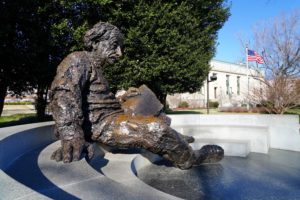The National Academies are a private, nongovernmental organization advising the federal government on science, engineering, and medicine. Abraham Lincoln authorized the creation of the National Academy of Sciences in 1863. The National Academy of Engineering followed in 1964 and the National Academy of Medicine in 1970. Most people hear of them only when a committee publishes its report—if it happens to be a slow news day (remember those?).
When any branch of the US government needs advice about a technical matter, the National Academies convene a committee to examine the issues and report back. Program officers on staff determine what kind of expertise is necessary and assemble the committee accordingly.
I’ve served on several such committees for the National Academy of Sciences’ Nuclear and Radiation Studies Board. Several were commissioned by the Department of Energy, and one by the Senate. Most recently, our committee examined three alternatives for supplemental treatment of low-activity waste at the Hanford Nuclear Reservation.
Legacy of WWII and the Cold War
During the Manhattan Project and the Cold War, the Hanford Nuclear Reservation in the state of Washington produced plutonium for nuclear weapons. This production generated millions of gallons of radioactive and hazardous wastes, now in 177 underground tanks. During WWII it wasn’t possible to make stainless steel, as the alloying elements were unavailable. So they made the tanks with carbon steel. Some of them have corroded so badly that they are leaking radioactive wastes into the ground water.
By removing the radionuclides that contribute most of the radioactivity, the U.S. Department of Energy plans to retrieve the waste from the tanks to produce high-level waste (with more than 90% of the radioactivity and less than 10% of the total volume). The remainder is low-activity waste.
The original plan was to vitrify* the high-level waste and at least one-third of the low-activity waste. The high-level fraction will go to a deep geological repository, while the low-activity waste will go to near-surface facilities (shallow land burial).
DOE is considering approaches other than vitrification for the remaining low-activity waste. One of these is to mix it with cementitious materials to make a waste-form grout. The Government Accountability Office recommended that “DOE develop updated information on the performance of treating [low-activity waste] with alternate methods, such as grout, before it selects an approach for treating supplemental [low-activity waste].”
These grouts immobilize not only the radioactive waste, but also toxic heavy metals and other hazardous materials that may be present. This approach has been successful at South Carolina’s Savannah River Site, where Saltstone grout comprises low-activity waste, portland cement, slag cement, and fly ash. Workers place liquid Saltstone into concrete vaults, where it sets and hardens. When a vault is full, they cover it with a concrete cap and layers of soil. You can download the committee’s final report here.

National Academies committees
Serving on a National Academies committee is highly rewarding. Committee members volunteer their time, while expenses are covered. But it’s such an interesting experience that it’s well worth it. You get to meet other experts from academia, industry, and government. Naturally I know people of comparable caliber in my own field. But working on these committees has brought me into contact with experts in other fields whom I wouldn’t have met otherwise. In a sense, the experience is similar to graduate school, but with people who have already made their marks in their fields.
You also get to work on complex problems at the intersection of science and government policy. National Academies staff make the process go smoothly. They convene the committee, handle the logistics, and invite outside experts to address us. Finally, they shepherd the committee report through rigorous review.
As politicians and others sow distrust in government, the National Academies inject scientific information, analysis, and reason into the debate.
*Form it into glass. The idea is that glass should be chemically inert and therefore stable. In fact, depending on the environment, the glass may deteriorate and release the waste it contains. Vitrification is much more expensive than the alternative processes.
